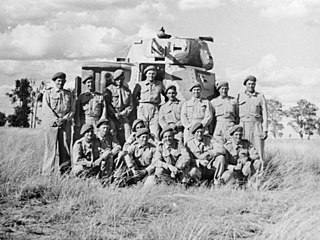
Australian Light Horse were mounted troops with characteristics of both cavalry and mounted infantry, who served in the Second Boer War and World War I. During the inter-war years, a number of regiments were raised as part of Australia's part-time military force. These units were gradually mechanised either before or during World War II, although only a small number undertook operational service during the war. A number of Australian light horse units are still in existence today.
This is the complete order of battle of Allied and German forces involved during Operation Market Garden.

This article describes the current structure of the Australian Army. It includes the army's order of battle and the headquarters locations of major units. Members of the Australian Army also serve within joint units of the Australian Defence Force which fall outside the direct command of the Australian Army.

The 3rd Armoured Division was an armoured unit of the Australian Army during World War II. Originally raised in 1921 as the 1st Cavalry Division, the formation had been converted into a motor division in early 1942, before adopting the armoured designation in November 1942. A Militia formation, the division undertook garrison duties in New South Wales and then Queensland and did not see combat before being disbanded in late 1943 and early 1944.

Armoured units made a relatively small, but important, contribution to Australia’s war effort during World War II. While Australia formed three armoured divisions and two independent armoured brigades during the war, Australian armoured units only saw action as independent regiments and companies supporting larger infantry formations. Early actions were fought in the Middle East by the divisional carrier regiments that supported the 6th, 7th and 9th Divisions, fighting in Libya, Egypt and Syria in 1941–42, before the Australian divisions returned to Australia in 1942–43. During the early fighting in the Pacific, there was a limited role for armoured formations, although one armoured regiment – the 2/6th – took part in the fighting around Buna–Gona in late 1942. Later in the war, though, during the Huon Peninsula, Bougainville and Borneo campaigns of 1943–45, several armoured units were used by Australian forces in the infantry support role.
The following units of the German First Army and British Expeditionary Force fought in the Battle of Mons in World War I.

The 2nd Armoured Brigade was a formation of the Australian Army during World War II. The brigade was formed in July 1941, at Puckapunyal, Victoria, from Second Australian Imperial Force volunteers. It was assigned to the 1st Armoured Division in July 1941, with the intention of deploying it to the Middle East. However, it was reassigned to home defence following Japan's entry into the war, and was then transferred to the 3rd Armoured Division in October 1942. The brigade remained in Australia, undertaking defensive duties in Victoria and Queensland before being disbanded in January 1944. While it did not see any active service as a formation, some of its constituent units eventually took part in the campaigns on Tarakan, Labuan, Bougainville and around Aitape–Wewak in 1944–1945 after transferring to other brigades.
The Allied invasion of Italy, a phase of the Mediterranean Theater of World War II, took place on 3 September at Reggio di Calabria, and on 9 September 1943 at Taranto and Salerno. Allied naval forces landed American and Commonwealth troops on the beaches of southern Italy where they faced resistance from Axis forces.

This is the order of battle for the ground campaign in the Gulf War between U.S. and Coalition Forces and the Iraqi Armed Forces between February 24–28, 1991. The order that they are listed in are from west to east. Iraqi units that were not in the Kuwaiti Theater of Operations are excluded from this list. Some Iraqi divisions remained un-identified by Department of Defense intelligence and a number of the details of the Iraqi order of battle are in dispute among various authoritative sources.

This is the order of battle for the invasion of Iraq during the Iraq War between coalition forces and the Iraqi Armed Forces; Fedayeen Saddam irregulars; and others between March 19 and May 1, 2003.
In September 1939, the British Army was in process of expanding their anti-aircraft and mobile assets. Among these new changes was the formation of Anti-Aircraft Command which was formed on 1 April 1939, and the 1st Armoured Division formed in 1937. The list below will include the British Army units, colonial units, and those units which were in the process of formation.

This is an order of battle listing the Allied and Ottoman forces involved in the Gallipoli campaign during 1915.
This page details the South African Army order of battle in 1940, before and after the formation of expeditionary forces.
The Structure of the Egyptian Expeditionary Force over the course of the First World War is shown below.